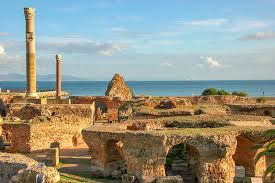The Egyptians referred to the people west of the Nile, ancestral to the Berbers, as Libyans. The Libyans were agriculturalists like the Mauri of Morocco and the Numidians of central and eastern Algeria and Tunis. They were also nomadic, having the horse, and occupied the arid pastures and desert, like the Gaetuli. Berber desert nomads were typically in conflict with Berber coastal agriculturalists.
The Phoenicians were Mediterranean seamen in constant search for valuable metals such as copper, gold, tin, and lead. They began to populate the North African coast with settlements—trading and mixing with the native Berber population. In 814 BCE, Phoenicians from Tyre established the city of Carthage. By 600 BCE, Carthage had become a major trading entity and power in the Mediterranean, largely through trade with tropical Africa. Carthage’s prosperity fostered the growth of the Berber kingdoms, Numidia and Mauretania. Around 500 BCE, Carthage provided a strong impetus for trade with Sub-Saharan Africa. Berber middlemen, who had maintained contacts with Sub-Saharan Africa since the desert had desiccated, utilized pack animals to transfer products from oasis to oasis. Danger lurked from the Garamantes of Fez, who raided caravans. Salt and metal goods were traded for gold, slaves, beads, and ivory.
 The Carthaginians were rivals to the Greeks and Romans. Carthage fought the Punic Wars, three wars with Rome: the First Punic War (264 to 241 BCE), over Sicily; the Second Punic War (218 to 201 BCE), in which Hannibal invaded Europe; and the Third Punic War (149 to 146 BCE). Carthage lost the first two wars, and in the third it was destroyed, becoming the Roman province of Africa, with the Berber Kingdom of Numidia assisting Rome. The Roman province of Africa became a major agricultural supplier of wheat, olives, and olive oil to imperial Rome via exorbitant taxation. Two centuries later, Rome brought the Berber kingdoms of Numidia and Mauretania under its authority. In the 420s CE, Vandals invaded North Africa and Rome lost her territories. The Berber kingdoms subsequently regained their independence.
The Carthaginians were rivals to the Greeks and Romans. Carthage fought the Punic Wars, three wars with Rome: the First Punic War (264 to 241 BCE), over Sicily; the Second Punic War (218 to 201 BCE), in which Hannibal invaded Europe; and the Third Punic War (149 to 146 BCE). Carthage lost the first two wars, and in the third it was destroyed, becoming the Roman province of Africa, with the Berber Kingdom of Numidia assisting Rome. The Roman province of Africa became a major agricultural supplier of wheat, olives, and olive oil to imperial Rome via exorbitant taxation. Two centuries later, Rome brought the Berber kingdoms of Numidia and Mauretania under its authority. In the 420s CE, Vandals invaded North Africa and Rome lost her territories. The Berber kingdoms subsequently regained their independence.
Christianity gained a foothold in Africa at Alexandria in the 1st century CE and spread to Northwest Africa. By 313 CE, with the Edict of Milan, all of Roman North Africa was Christian. Egyptians adopted Monophysite Christianity and formed the independent Coptic Church. Berbers adopted Donatist Christianity. Both groups refused to accept the authority of the Roman Catholic Church.
As Carthaginian power grew, its impact on the indigenous population increased dramatically. Berber civilization was already at a stage in which agriculture, manufacturing, trade, and political organization supported several states. Trade links between Carthage and the Berbers in the interior grew, but territorial expansion also resulted in the enslavement or military recruitment of some Berbers and in the extraction of tribute from others. By the early 4th century BCE, Berbers formed one of the largest element, with Gauls, of the Carthaginian army. In the Revolt of the Mercenaries, Berber soldiers participated from 241 to 238 BCE after being unpaid following the defeat of Carthage in the First Punic War. Berbers succeeded in obtaining control of much of Carthage’s North African territory, and they minted coins bearing the name Libyan, used in Greek to describe natives of North Africa. The Carthaginian state declined because of successive defeats by the Romans in the Punic Wars; in 146 BCE the city of Carthage was destroyed. As Carthaginian power waned, the influence of Berber leaders in the hinterland grew. By the 2nd century BCE, several large but loosely administered Berber kingdoms had emerged. Two of them were established in Numidia, behind the coastal areas controlled by Carthage. West of Numidia lay Mauretania, which extended across the Moulouya River in Morocco to the Atlantic Ocean. The high point of Berber civilization, unequaled until the coming of the Almohads and Almoravids more than a millennium later, was reached during the reign of Masinissa in the 2nd century BCE. After Masinissa’s death in 148 BCE, the Berber kingdoms were divided and reunited several times. Masinissa’s line survived until 24 CE, when the remaining Berber territory was annexed to the Roman Empire.
This article was taken off Wikipedia.